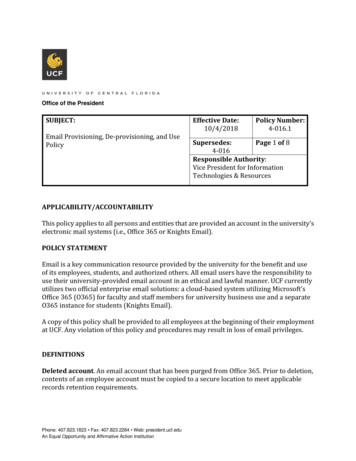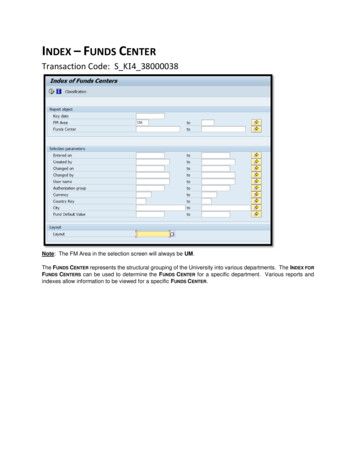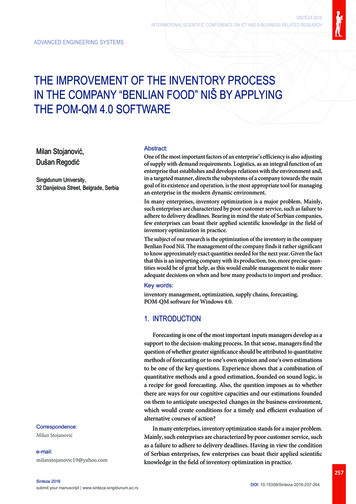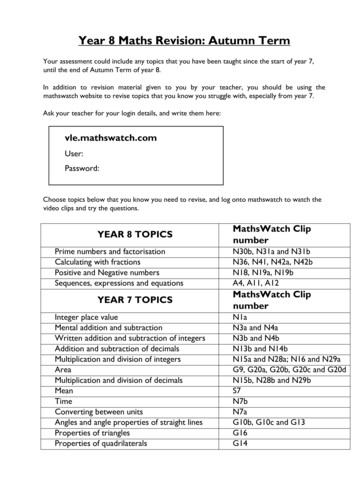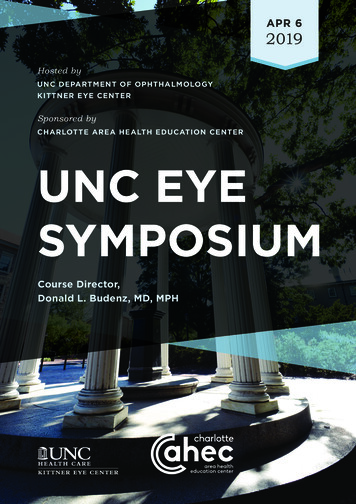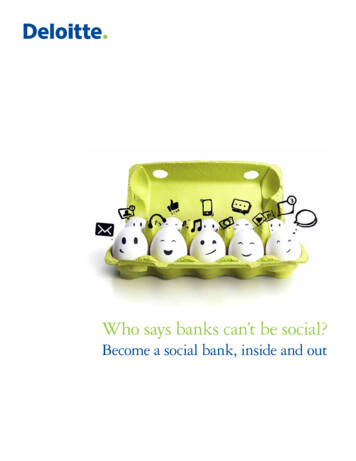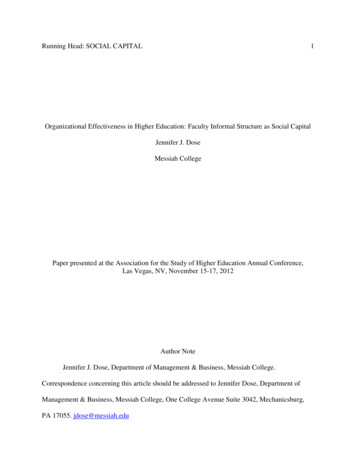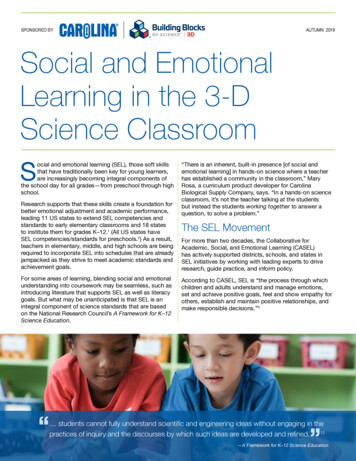
Transcription
SPONSORED BYAUTUMN 2019Social and EmotionalLearning in the 3-DScience ClassroomSocial and emotional learning (SEL), those soft skillsthat have traditionally been key for young learners,are increasingly becoming integral components ofthe school day for all grades—from preschool through highschool.Research supports that these skills create a foundation forbetter emotional adjustment and academic performance,leading 11 US states to extend SEL competencies andstandards to early elementary classrooms and 18 statesto institute them for grades K–12.1 (All US states haveSEL competencies/standards for preschools.2) As a result,teachers in elementary, middle, and high schools are beingrequired to incorporate SEL into schedules that are alreadyjampacked as they strive to meet academic standards andachievement goals.For some areas of learning, blending social and emotionalunderstanding into coursework may be seamless, such asintroducing literature that supports SEL as well as literacygoals. But what may be unanticipated is that SEL is anintegral component of science standards that are basedon the National Research Council’s A Framework for K–12Science Education.““There is an inherent, built-in presence [of social andemotional learning] in hands-on science where a teacherhas established a community in the classroom,” MaryRosa, a curriculum product developer for CarolinaBiological Supply Company, says. “In a hands-on scienceclassroom, it’s not the teacher talking at the studentsbut instead the students working together to answer aquestion, to solve a problem.”The SEL MovementFor more than two decades, the Collaborative forAcademic, Social, and Emotional Learning (CASEL)has actively supported districts, schools, and states inSEL initiatives by working with leading experts to driveresearch, guide practice, and inform policy.According to CASEL, SEL is “the process through whichchildren and adults understand and manage emotions,set and achieve positive goals, feel and show empathy forothers, establish and maintain positive relationships, andmake responsible decisions.”3 students cannot fully understand scientific and engineering ideas without engaging in the15practices of inquiry and the discourses by which such ideas are developed and refined.”—A Framework for K–12 Science Education
“Employers frequently list teamwork, collaboration, andoral and written communication skills as highly valuableyet hard-to-find qualities in potential new hires,” DavidJ. Deming, a Harvard professor and research fellow atthe National Bureau of Economic Research, wrote in a2017 NBER report. He notes that although workplaceautomation is increasing, “Social interaction is perhaps themost necessary workplace task for which there is currentlyno good machine substitute.”9CASEL lists the core competencies of socialand emotional learning as:⁕ Self-awareness⁕ Self-management⁕ Social awareness⁕ Relationship skills⁕ Responsible decision-makingDespite widespread support for students acquiring softskills, studies have found that SEL training for teachers islacking in most schools, primarily due to time and fundingconstraints.10 In a study commissioned by CASEL, themajority of teachers responding support SEL but only 55percent reported receiving some form of SEL training.11In addition, a 2017 national scan of teacher preparationin SEL found that “an overwhelming majority” of teacherpreparation programs in US colleges do not addressany of the five core students’ SEL competencies.12 Andreferring to a busy, day-to-day classroom, over a third ofrespondents to a 2015 study said other demands takepriority over SEL.13CASEL maintains that SEL programming benefits childrenof all grade levels, of all races, of all socioeconomicbackgrounds, and in all locations. Its findings have beencompiled from hundreds of studies, grabbing the attentionof policy makers, administrators, and classroom teachersalike. For example:⁕ A 2011 meta-analysis involving more than 270,000kindergarten through high school studentsdemonstrated that SEL participants had an11-percentile point gain in academic achievement.4⁕ A 2017 meta-analysis of 82 research studies ofmore than 97,000 grades K–12 students worldwidesupported that SEL programming can have positiveimpacts on academics, conduct problems, emotionaldistress, and drug use up to 18 years later.5Science Standards and SELAs of the end the 2018–19 school year, science standardsbased on the Framework, such as the Next GenerationScience Standards*, had been adopted in 42 states andthe District of Columbia, representing nearly two-thirds ofall US students.14 The Framework presents three equallyimportant dimensions: science and engineering practices,disciplinary core ideas, and crosscutting concepts.Science and engineering practices—those behaviors thatscientists engage in as part of their daily work routines—require students to draw on and develop soft skills as theyinteract to investigate phenomena.⁕ A review of six SEL interventions showed that for everydollar invested, there was an economic return of 11.6⁕ Teachers who themselves have high levels of socialand emotional competence are better able to protectthemselves from burnout, leading to higher retentionrates.7Additionally, employers are seeking candidates who havestrong soft skills as well as technical knowledge. In a 2015Wall Street Journal survey of 900 executives, 92 percentresponded that skills such as problem-solving and criticalthinking are equally or more important than technical skills.8“It’s important to understand the concept of phenomena tounderstand how it relates to social-emotional skills,” Rosasays. A phenomenon is a naturally occurring, observable2
event that can generate student interest and elicitquestions. In a science investigation, it can be presentedthrough pictures, video clips, lab demonstrations, or as anoccurrence that students experience in the environmentaround them—and then reiterated through hands-onactivities that strengthen students’ understanding.groups—to problem-solve, build models, and developanswers to driving questions as the teacher facilitateslearning. While students work, even a simple thumbs-upor thumbs-down from a student can signal to the teacherhow that student is handling the investigation on anemotional level and whether intervention is needed.Facilitating Student SuccessTo develop vocabulary and effective communication skills,students should have opportunities to engage in familiarand relatable real-world phenomena to furnish a commoncontextual reference. A teacher’s guide can provideguidance for this anchoring phenomena and lessons for theActivity Before Concept, Concept Before Vocabulary format.As students consider the phenomena along with aninvestigation’s driving question, they should have multipleopportunities to engage in discourse as they developclaims and support those claims with evidence andreasoning—and as they effectively deal with conflict,control their impulses, and respectfully listen to oneanother. Frustration points can be reduced by offeringoptions in gathering information, such as literacy readers,printed investigation sheets, and digital simulations andwhiteboard activities.⁕ Anchoring phenomena should serve as the mainfocus of an investigation. Introduced visually, suchas through a video clip, it can spark students’interest, guiding them to make connections anddevelop relationship and social awareness skillsas they communicate their thoughts, listen to theirclassmates’ ideas, and strive to understand oneanother’s perspectives.“There also are purposeful ways to keep kids accountablefor actively listening to classmates,” Rosa says. InBuilding Blocks of Science 3D, for example, grades 3–5investigation sheets prompt students to write what theylearn from other students in their groups, honing theirrelationship skills as well as their scientific understanding.⁕ Investigative phenomena encourage students todevelop a deeper understanding as they perseverein overcoming obstacles to develop explanationsof the phenomena and then build models or designsolutions to a problem. When presenting theirdesigns or findings to classmates, students need tocommunicate clearly to present their reasoning usingevidence-based claims while classmates are activelyengaged through listening and notetaking.SEL can be extendedbeyond the scienceclassroom through takehome components ofan investigation, leadingstudents to make ethical,constructive choices aboutsocial behavior. Rosaexplains that when familiesare connected with thescience activities, studentsare motivated to apply whatthey’re learning to the well-beingof the community.“Hands-on science hits all of the SEL pieces that a teachercan incorporate in the classroom,” Rosa says. (See page4.) She notes that curriculum developed to support threedimensional learning, such as Building Blocks of Science 3D, leads students to work collectively—in pairs or smallAs students complete theirhands-on investigations, they canbuild self-awareness by writing intheir science notebooks whethertheir solutions helped make sense of the phenomenaand how they could improve their ideas, setting thestage for growth by acknowledging their strengths andlimitations and building confidence to persevere in futureinvestigations—both in and out of the classroom.3
Science and Engineering Practice*Social and Emotional Competency ExamplesAsking questions and defining problems⁕ Relationship skills: communicate clearly, listen well, cooperate whileInvestigate sound waves: Can you see vibrations?How does the speed of vibrations affect sound?(grades K–2)⁕ Social awareness: understand perspectives of others, recognizeengaging in discoursestrengths, adopt a growth mindset⁕ Self-management: control impulsesDeveloping and using models⁕ Relationship skills: negotiate conflict, cooperateStudent teams design, plan, and build an object toprevent the sun from warming sand. (grades K–2)⁕ Responsible decision-making: make constructive choices aboutbehavior⁕ Self-management: persevere, set and achieve goals⁕ Social awareness: understand perspectives of othersAnalyzing and interpreting data⁕ Relationship skills: cooperate with others, seek and offer help whenStudents monitor Wisconsin Fast Plants andbutterfly larva, adding questions to class chartsand referring to the charts throughout the unit.(grades 3–5) Using mathematics and computationalthinkingStudents collect volume data of water to modeland graph the distribution of water on Earth.(grades 3–5)Constructing explanations and designingsolutionsStudents design an invention to show forcesand interaction, allowing autonomy in devising asolution and the discovery that there can be morethan one solution to a problem. (grades 3–5)needed⁕ Self-management: persevere to overcome obstacles⁕ Self-awareness: recognize strengths, adopt a growth mindset, beoptimistic⁕ Relationship skills: seek and offer help when needed⁕ Self-awareness: recognize strengths, adopt a growth mindset, beoptimistic⁕ Self-management: persevere to overcome obstacles, manage stress,set and achieve goals⁕ Relationship skills: cooperate with others, deal effectively with conflict⁕ Self-management: persevere to overcome obstacles, set and achievegoals⁕ Responsible decision-making: connect with the community toinvestigate solutions⁕ Self-awareness: recognize strengths, adopt a growth mindset, beoptimistic⁕ Social awareness: recognize that there may be more than one solutionEngaging in argument from evidenceEach student in a group draws a part of the plantlife cycle. Then the class considers the similaritiesand differences of each group’s illustrations.(grades 3–5)⁕ Relationship skills: communicate clearly, listen well, cooperate whileengaging in discourse, deal effectively with conflict⁕ Self-management: control impulses, manage stress⁕ Social awareness: understand perspectives of others, empathize withothersObtaining, evaluating, and communicatinginformation⁕ Relationship skills: communicate clearly, listen well, cooperate whileEngineer designs to show how glaciers, rivers, andEarth’s natural processes change the land; presenterosion models to classmates. (grades K–2)⁕ Self-awareness: express confidence, be optimisticengaging in discourse, deal effectively with conflict⁕ Self-management: manage stress, control impulses⁕ Social awareness: understand perspectives of others, empathize withothers*Examples are from Building Blocks of Science 3D curriculum.4
REFERENCES1.Collaborative for Academic, Social, and EmotionalLearning. n.d. “Collaborating States Initiative.” AccessedJuly 15, 2019. rating-states-initiative/.2.Collaborative for Academic, Social, and EmotionalLearning. n.d. “Collaborating States Initiative.” AccessedJuly 15, 2019. rating-states-initiative/.3.Collaborative for Academic, Social, and EmotionalLearning. n.d. “What is SEL?” Accessed July 15, 2019.https://casel.org/what-is-sel/.4.Durlak, J. A.; Weissberg, R. P.; Dymnicki, A. B.; Taylor,R. D.; and Schellinger, K. B. 2011. “The Impact ofEnhancing Students’ Social and Emotional Learning: AMeta-Analysis of School-Based Universal Interventions.”Child Development, 82(1): pages 405–432.5.Durlak, J. A.; Weissberg, R. P.; Taylor, R. D.; and Oberle,E. 2017. “Promoting Positive Youth DevelopmentThrough School-Based Social and Emotional LearningInterventions: A Meta-Analysis of Follow-Up Effects.”Child Development, 88(4): pages 1156–1171.6.Belfield, C.; Bowden, B.; Klapp, A.; Levin, H.; Shand, R.;and Zander, S. 2015. “The Economic Value of Social andEmotional Learning.” Center for Benefit-Cost Studiesin Education, Teachers College, Columbia University.Accessed July 18, 2019. SEL-Revised.pdf.7.Jennings, P. A., and Greenberg, M. T. 2009. “TheProsocial Classroom: Teacher Social and EmotionalCompetence in Relation to Student and ClassroomOutcomes.” American Educational ResearchAssociation.8.Davidson, Kate. 2016. “Employer’s Find ‘Soft Skills’Like Critical Thinking in Short Supply.” The Wall StreetJournal, August 30, 2016. Accessed July 24, lls-likecritical-thinking-short-supply.9.Deming, David J. 2017. “The Value of Soft Skillsin the Labor Market.” The National Bureau ofEconomic Research, NBER Reporter 2017 Number4. Accessed July 30, 2019. tml. Pages 1, 3.10. DePaoli, J. L.; Atwell, M. N.; and Bridgeland, J. CivicEnterprises with Hart Research Associates. A Report forCASEL. n.a. “Ready to Lead: A National Principal Surveyon How Social and Emotional Learning Can PrepareChildren and Transform Schools.” Page 5.11. Civic Enterprises with Peter D. Hart ResearchAssociates. A Report for CASEL. n.a. “The MissingPiece: A National Teacher Survey on How Socialand Emotional Learning Can Empower Children andTransform Schools.” Page 8.12. University of British Columbia. 2017. “To Reach theStudents, Teach the Teachers: A National Scan ofTeacher Preparation and Social & Emotional Learning.”Page 9.13. Editorial Projects in Education Inc. The EducationWeek Research Center. 2015. “Social and EmotionalPerspectives from America’s Schools.” Page 22.14. National Science Teaching Association. n.a. “About theNext Generation Science Standards.” Accessed July 15,2019. https://ngss.nsta.org/about.aspx.15. National Research Council. 2011. A Framework for K-12Science Education: Practices, Crosscutting Concepts,and Core Ideas. Committee on a Conceptual Frameworkfor New K–12 Science Education Standards. Board onScience Education, Division of Behavioral and SocialSciences and Education. Washington, DC: The NationalAcademies Press. Page 218.5
ABOUTCAROLINABUILDING BLOCKS OFSCIENCE 3DCarolina Biological Supply Company is a leadingsupplier of science teaching materials for preschoolthrough college-level classrooms. Headquartered inBurlington, North Carolina, it serves customers worldwide,including teachers, professors, informal educators, andprofessionals in health- and science-related fields. Carolinais the exclusive developer, publisher, and distributor of theBuilding Blocks of Science 3D grades K–5 curriculum. Building Blocks of Science 3D is a hands-on,phenomena-based grades K–5 curriculum developedto establish a solid foundation in elementary sciencewhile addressing the NGSS. It provides all students withmultiple opportunities to build social and emotional skillsas they engage in three-dimensional learning anchored inphenomena.*Next Generation Science Standards is a registered trademarkof Achieve. Neither Achieve nor the lead states and partners thatdeveloped the Next Generation Science Standards were involved inthe production of, and do not endorse, these products.LEARN .334.55516CB884032202
on the National Research Council’s A Framework for K–12 Science Education. “There is an inherent, built-in presence [of social and emotional learning] in hands-on science where a teacher has established a community in the classroom,” Mary Rosa, a curriculum product developer for Car


